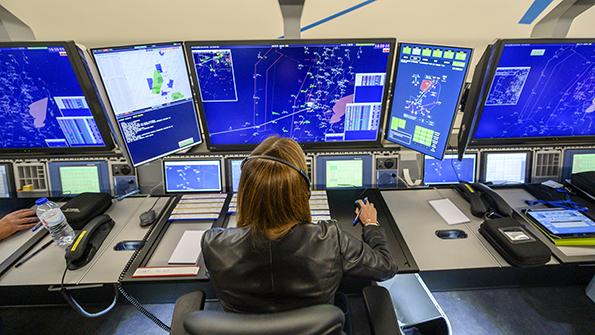Europe’s Free Route Airspace Push Is Delayed By Russia-Ukraine War

Systems boosting airspace efficiencies are coming into focus in Europe.
Europe’s air navigation service providers are pushing ahead with the implementation of free route airspace—though completion is scheduled for 2024, about a year later than initially planned—with the long-term aim of boosting efficiency and unlocking cost and fuel savings.
The delays are linked to the Russian invasion of Ukraine, Eurocontrol Director General Eamonn Brennan told Aviation Week Oct. 4 at a conference called “Where to Next for European Aviation?” at Eurocontrol headquarters in Brussels.
- New system should lead to fuel, cost and emissions savings
- France has implemented It over half of its airspace
The application of free route airspace (FRA) should bring about major fuel, emissions and cost savings, boosting efficiency through better routing and more flexibility for operators. With FRA, pilots are now able to plan a route between a defined entry and exit point rather than having to follow a set route mapped out by air traffic controllers.
“Estimates show that FRA could save as much as 1 billion nm, 6 million [metric tons] of fuel, 20 million [metric tons] of CO2 and €5 billion [$4.8 billion] in fuel savings,” Simon Hocquard, director general of the Civil Air Navigation Services Organization, said at the conference. “While Europe is along this journey of FRA, there is still much to do.”
“Realistically, it’s going to be 2024 before we have free route airspace really operable all over Europe,” Brennan said. “The Russian invasion has definitely slowed that down because there are a lot of other priorities—security issues become a top priority when you have a crisis like this.”
FRA projects are, however, in place across more than three-quarters of European airspace.
Eurocontrol says FRA is a key milestone in achieving free routing across European airspace on the road to the Single European Sky ATM Research (SESAR) program’s business trajectories and 4D profiles, which will make it possible to meet the demands of future airspace users for the next 50 years, including civil and military uncrewed aircraft systems, supersonic and hypersonic transport, spaceplane operations to suborbit and orbit, high--altitude pseudo-satellite platforms, plus balloons and airships.
Florian Guillermet, director of France’s DSNA, said at the conference that the air navigation service provider (ANSP) is moving ahead with changes including FRA, despite the ongoing lack of clarity at a European political level about Single European Sky 2+ (SES) reforms.
“For sure, a change of regulatory framework will force things onto us,” he said. “On the other hand, I think we’ve all acknowledged today that we have to move ahead regardless of whether SES 2+ will become reality. I think we can do much better with what we have today.”
The ANSP implemented FRA in France in half its airspace a year ago, Guillermet said. “That’s work we have done in coordination with Eurocontrol, other states and airlines. Our controllers have been trained and are happy to work on it because they feel they are contributing to the sustainability issue.”
Brennan described that long-awaited SES revamp, which the aviation industry says could lead to fuel savings of 10%, as “the elephant in the room.” He said: “I don’t think it’ll ever happen in the way we all would like it to happen—a real Single European Sky. But we can make improvements.”
Eurocontrol is also looking ahead to a technology upgrade with its investment in a new network management system “The system is the way to do this. One of the big answers about how to start using the Single European Sky is just technology,” Brennan said.
That new system is part of the overarching integrated network management program, which is planned to include the incremental renewal of all the network manager’s main operational systems, resulting in a new digital architecture by 2030. The program encompasses issues such as enterprise architecture, agile development, artificial intelligence and machine learning, big data and data analytics, probability modeling, predictive analysis, cloud solutions, scalable systems and cyber-resilience.
The network management system is expected to go live at the end of the first quarter of 2024. At that point, Brennan said, “[the system will] go stratospheric . . . with one of the most modern systems in the world, and I think it will give us an additional 10% capacity boost by about 2025.”
Legacy systems will evolve gradually over the following five years toward the new integrated network management system, which is designed to be able to manage 13.8 million flights per year, up from the 9.5 million (or 85% of 2019 levels) expected this year.
Between now and then, the industry and its ANSPs will have to face a challenging 2023 as capacity continues to ramp up, putting more pressure on the network, partly as a result of the invasion of Ukraine and its consequences for European airspace.
Brennan said one area of improvement for the region would be smoother cooperation between the civil and military sectors. “We’re seeing a huge amount of airspace operating military flights [due to the Russia-Ukraine war],” he said. “This year we’re operating 90% of 2019 flights with 80% of the airspace.”

